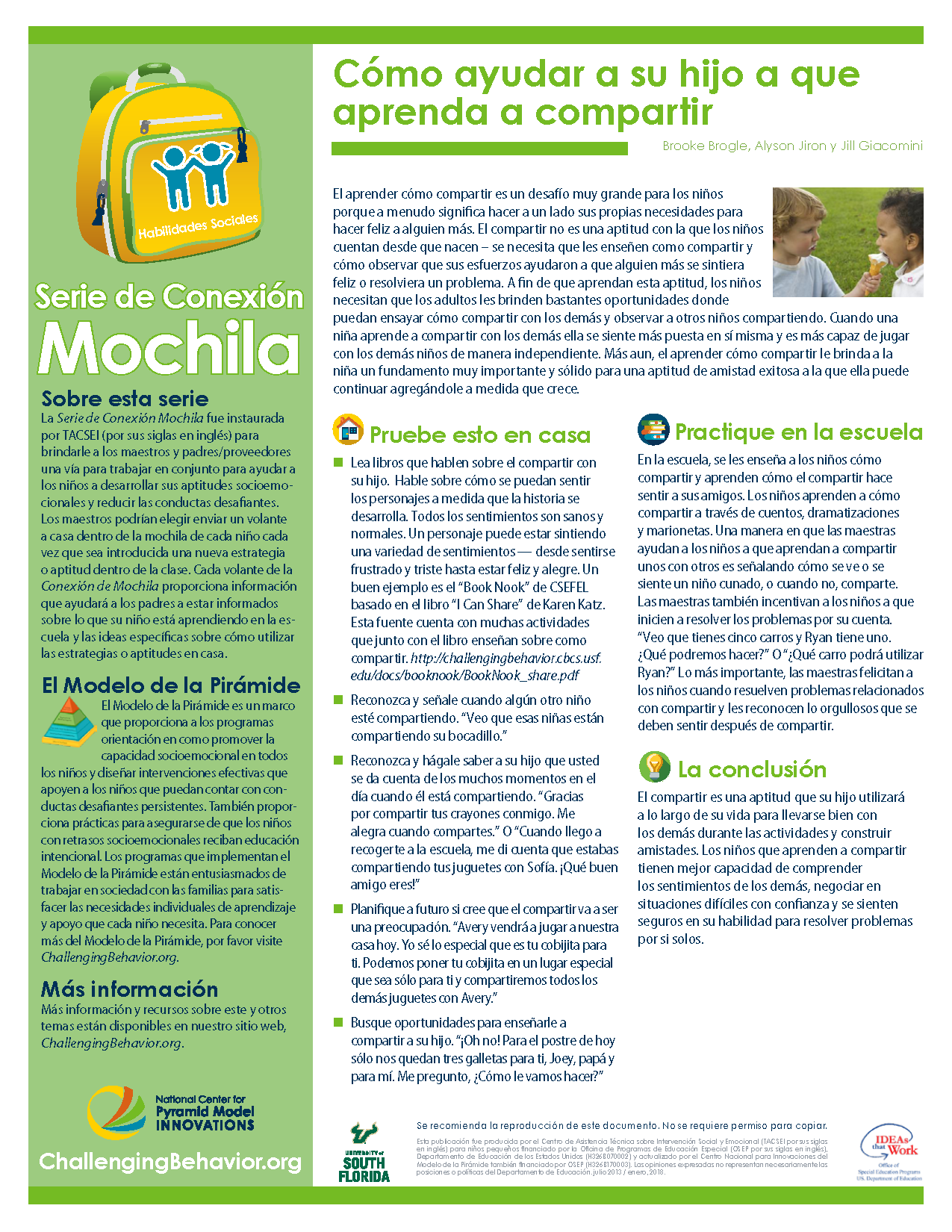Trainers can use the below resources during their training sessions.
The implementation checklists below are great to use in Pyramid Model training workshops. These include sections on each level of the Pyramid Model that relates to their relevant Pyramid Model practices (i.e., early intervention, infant-toddler, preschool).
- At the beginning of a workshop, have the participant review the practice implementation checklist and identify the practices that are strengths and the practices that could be improved or expanded.
- At the end of the workshop, have the participant identify the practices that they will focus on for implementation.

The Early Intervention Implementation Checklist is designed to align with the Early Intervention Pyramid Practices Fidelity Instrument (EIPPFI). Coaches and early interventionists can use this tool to support early interventionists’ self-reflection of the implementation of Pyramid practices, and prepare for shared goals and action planning.

This resource provides family child care home providers with best practices that can be used to support children at each tier of the Pyramid Model.

The Pyramid Model Practices Implementation Checklist for Infant and Toddler Classrooms is a tool designed to be used by practitioners to identify training and/or classroom implementation needs in eight areas. The checklist encourages individual self-reflection and discussion between classroom teachers and practitioner coaches.

The Pyramid Model Implementation Checklist is a tool designed to be used by practitioners to identify training and/or classroom implementation needs in seven areas: Responsive Relationships; Predictable Daily Schedules; Creating Effective Classroom Routines; Teaching Behavior Expectations across Classroom Routines; Teaching Social and Emotional Skills; Systematic Instructional Strategies; and Function-Based Assessment and Intervention Planning. The checklist encourages individual self-reflection and discussion between classroom teachers and practitioner coaches.
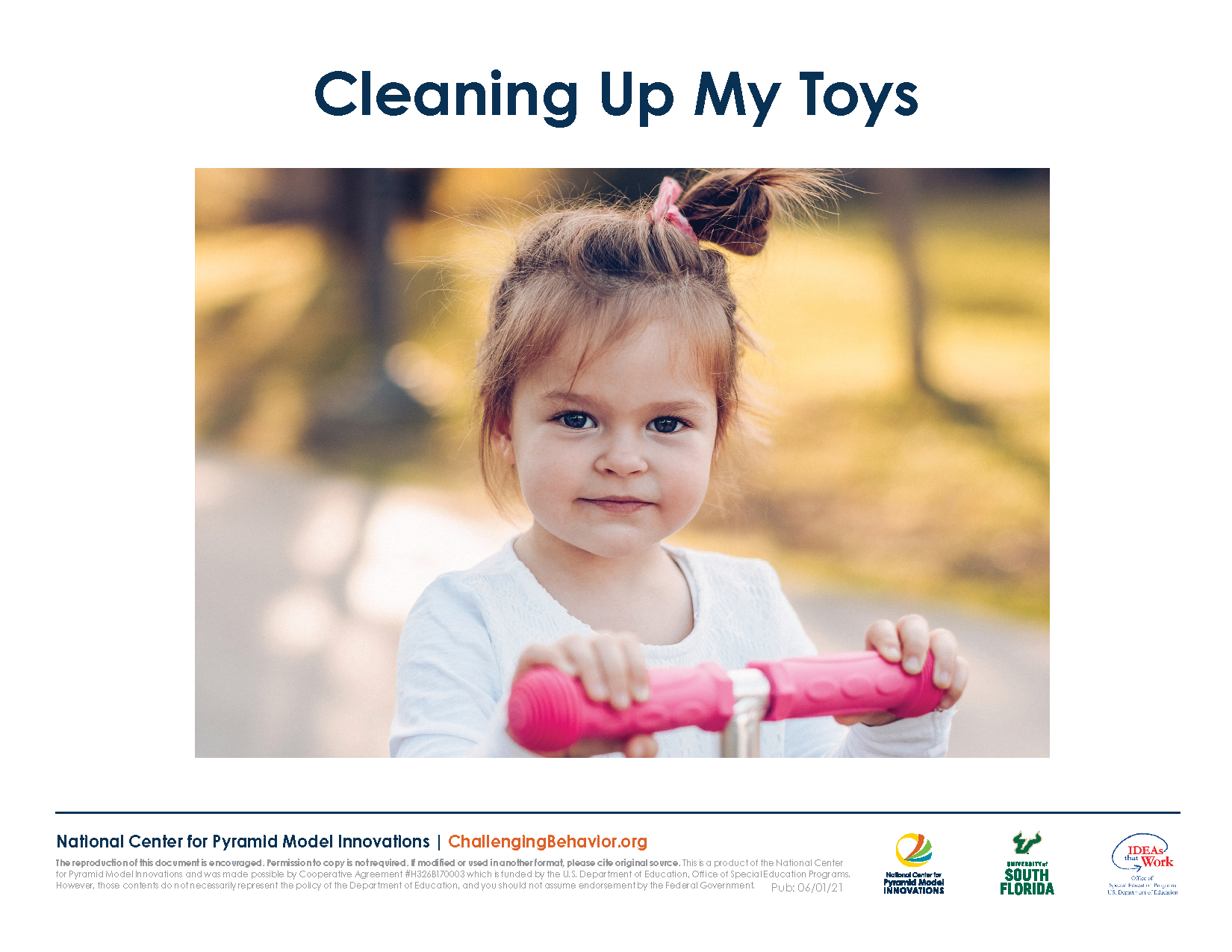
This sample scripted story shows a child learning the steps to cleaning up toys.

This sample scripted story shows a child learning the steps to cleaning up toys.

This tip sheet highlights the important considerations for making a scripted story about cleaning up toys.

This tip sheet highlights the important considerations for making a scripted story about cleaning up toys.

The Feeling Faces assist children with understanding their feelings and the feelings of others. It is important to teach children words to use to express feelings in replace of the use of challenging behavior. The feeling faces that follow can be used in a variety of ways to help children learn social emotional skills around use of emotional literacy and vocabulary.

The Feeling Faces assist children with understanding their feelings and the feelings of others. It is important to teach children words to use to express feelings in replace of the use of challenging behavior. The feeling faces that follow can be used in a variety of ways to help children learn social emotional skills around use of emotional literacy and vocabulary.

The Feeling Faces assist children with understanding their feelings and the feelings of others. It is important to teach children words to use to express feelings in replace of the use of challenging behavior. The feeling faces that follow can be used in a variety of ways to help children learn social emotional skills around use of emotional literacy and vocabulary.

The Feeling Faces assist children with understanding their feelings and the feelings of others. It is important to teach children words to use to express feelings in replace of the use of challenging behavior. The feeling faces that follow can be used in a variety of ways to help children learn social emotional skills around use of emotional literacy and vocabulary.

The Feeling Faces assist children with understanding their feelings and the feelings of others. It is important to teach children words to use to express feelings in replace of the use of challenging behavior. The feeling faces that follow can be used in a variety of ways to help children learn social emotional skills around use of emotional literacy and vocabulary.

The Feeling Faces assist children with understanding their feelings and the feelings of others. It is important to teach children words to use to express feelings in replace of the use of challenging behavior. The feeling faces that follow can be used in a variety of ways to help children learn social emotional skills around use of emotional literacy and vocabulary.

The Feeling Faces assist children with understanding their feelings and the feelings of others. It is important to teach children words to use to express feelings in replace of the use of challenging behavior. The feeling faces that follow can be used in a variety of ways to help children learn social emotional skills around use of emotional literacy and vocabulary.

The Feeling Faces assist children with understanding their feelings and the feelings of others. It is important to teach children words to use to express feelings in replace of the use of challenging behavior. The feeling faces that follow can be used in a variety of ways to help children learn social emotional skills around use of emotional literacy and vocabulary.

The Feeling Faces assist children with understanding their feelings and the feelings of others. It is important to teach children words to use to express feelings in replace of the use of challenging behavior. The feeling faces that follow can be used in a variety of ways to help children learn social emotional skills around use of emotional literacy and vocabulary.

The Feeling Faces assist children with understanding their feelings and the feelings of others. It is important to teach children words to use to express feelings in replace of the use of challenging behavior. The feeling faces that follow can be used in a variety of ways to help children learn social emotional skills around use of emotional literacy and vocabulary.

The Feeling Faces assist children with understanding their feelings and the feelings of others. It is important to teach children words to use to express feelings in replace of the use of challenging behavior. The feeling faces that follow can be used in a variety of ways to help children learn social emotional skills around use of emotional literacy and vocabulary. Includes introduction in Spanish and visual in English and Spanish.

This tip sheet provides families with strategies to help children predict what is coming next which helps make
transitions smoother.

This tip sheet provides families with strategies to help children predict what is coming next which helps make transitions smoother.

This sample scripted story shows a child learning the steps to brushing their teeth.

This sample scripted story shows a child learning the steps to brushing their teeth.
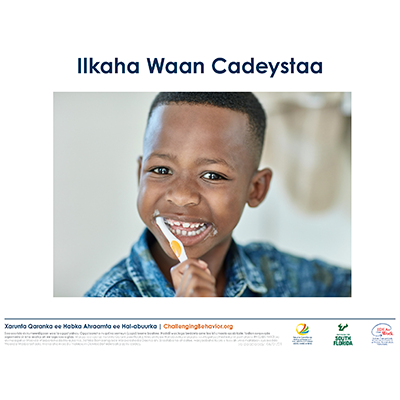
This sample scripted story shows a child learning the steps to brushing their teeth.

This sample scripted story shows a child learning the steps to brushing their teeth.

This tip sheet highlights the important considerations for making a scripted story about brushing teeth.
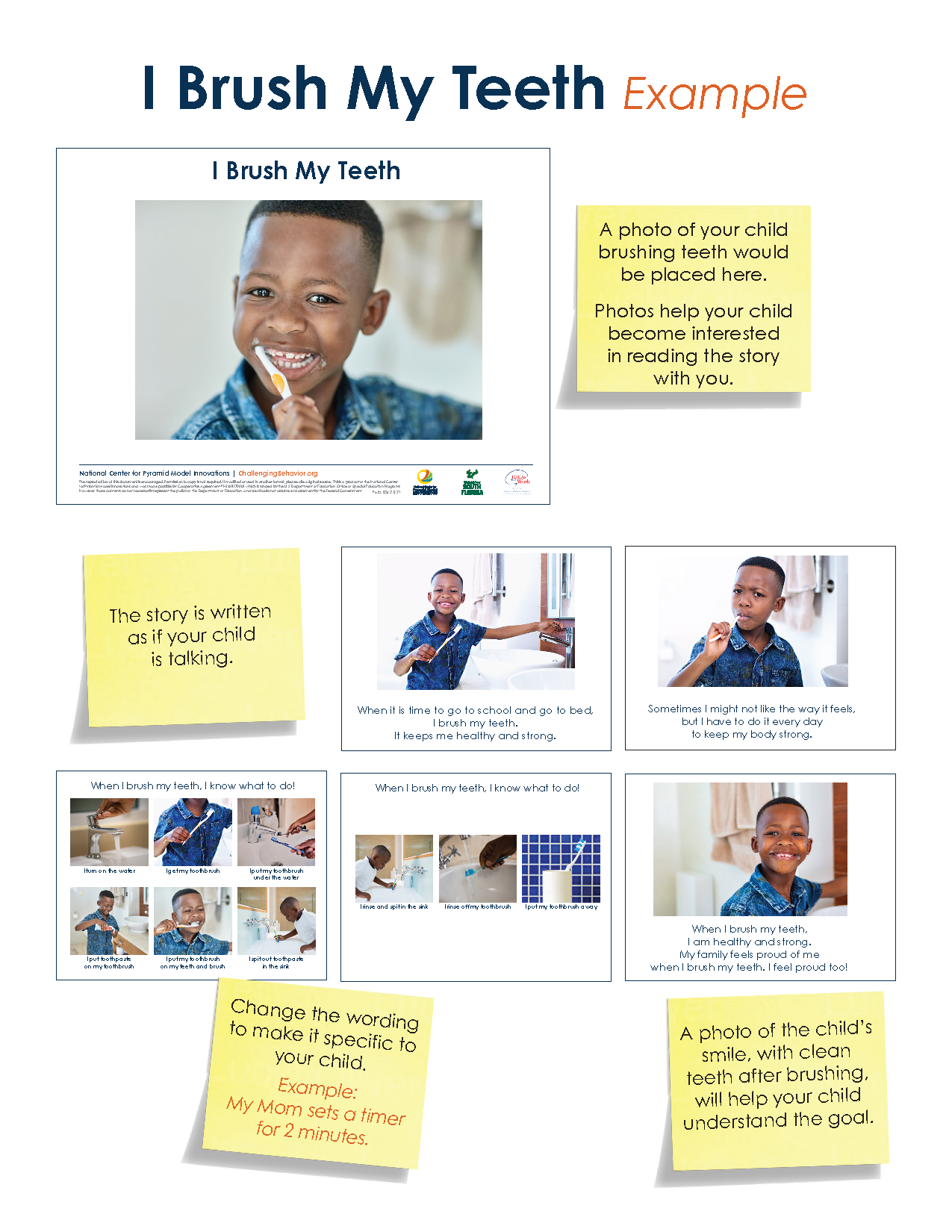
This tip sheet highlights the important considerations for making a scripted story about brushing teeth.

This sample scripted story shows how families might teach a child about expectations and family rules.

This sample scripted story shows how families might teach a child about expectations and family rules.

This tipsheet contains suggestions on how to develop and use scripted stories at home.
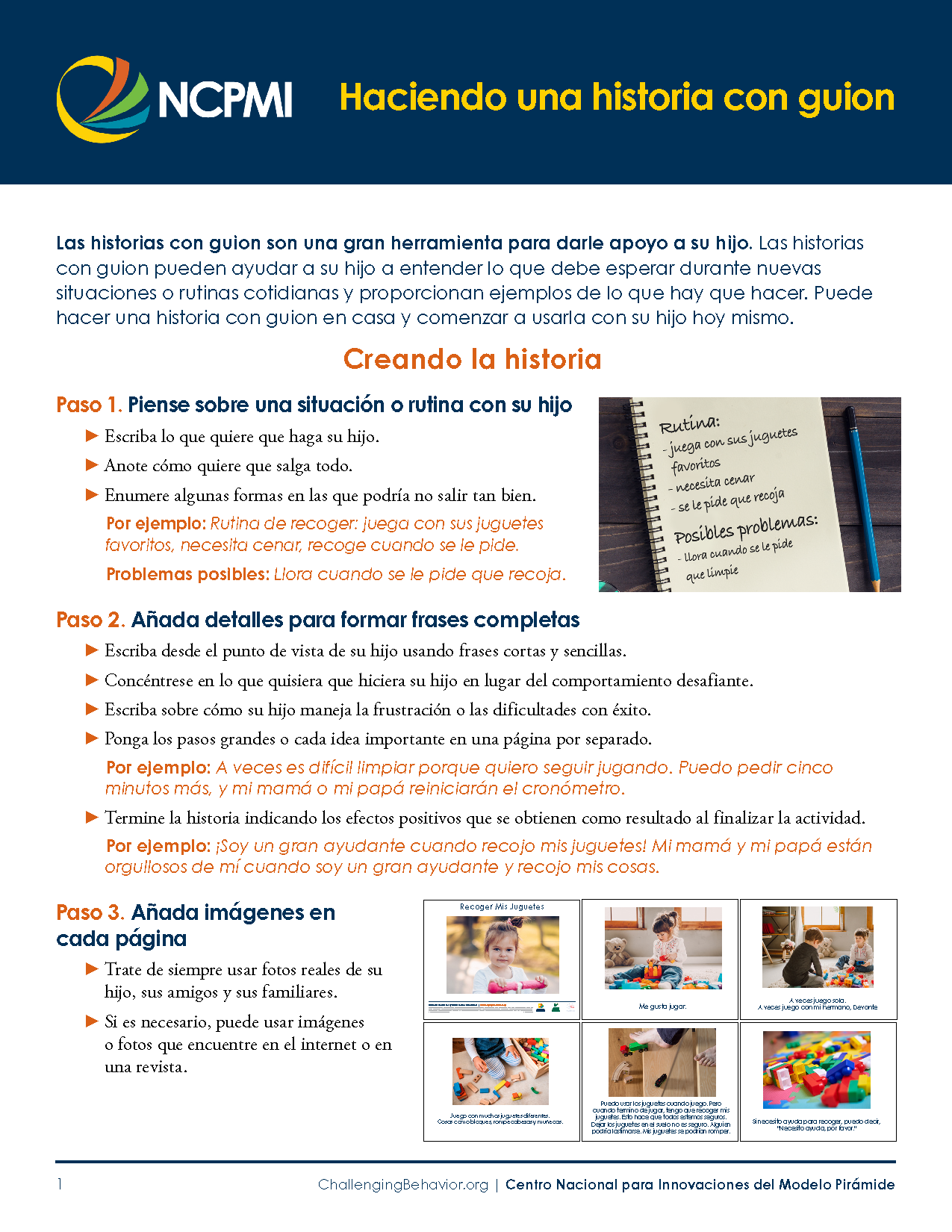
This tipsheet contains suggestions on how to develop and use scripted stories at home.

Sample poster showing how a family may use visuals to teach family rules.

Sample poster showing how a family may use visuals to teach family rules.

Providing positive encouragement is a powerful practice for helping children meet behavior expectations. This fact sheet provides ideas for how caregivers can deliver positive encouragement.

Providing positive encouragement is a powerful practice for helping children meet behavior expectations. This fact sheet provides ideas for how caregivers can deliver positive encouragement.

Providing positive encouragement is a powerful practice for helping children meet behavior expectations. This fact sheet provides ideas for how caregivers can deliver positive encouragement.

The Positive Solutions Family Routine Guide is used by parents and caregivers of children ages 2-5 years in developing an intervention plan for children who are using challenging behavior. The Guide gives suggestions for prevent, teach, and response strategies, organized by the function of the challenging behavior, within common family activities and routines. The guide is part of the Positive Solutions for Families workshop series.

The Positive Solutions Family Routine Guide is used by parents and caregivers of children ages 2-5 years in developing an intervention plan for children who are using challenging behavior. The Guide gives suggestions for prevent, teach, and response strategies, organized by the function of the challenging behavior, within common family activities and routines. The guide is part of the Positive Solutions for Families workshop series.

Positive Solutions for Families is an evidence-based, family-friendly workshop of seven sessions to help professionals working with families of children ages 2-5 years. Zip folder provides all materials needed by a facilitator to provide the workshop series to participants.

Positive Solutions for Families is an evidence-based, family-friendly workshop of seven sessions to help professionals working with families of children ages 2-5 years. Zip folder provides all materials needed by a facilitator to provide the workshop series to participants.
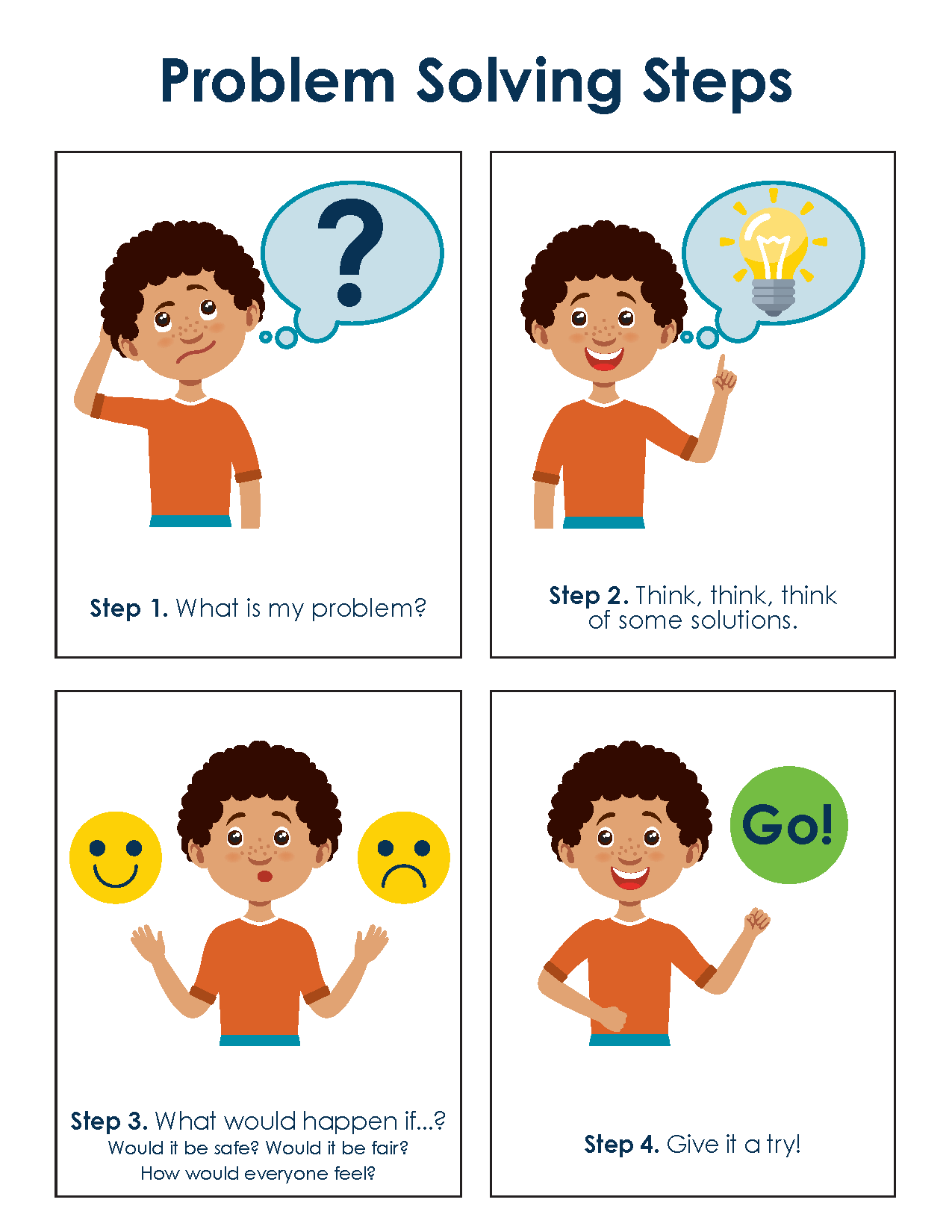
Problem solving steps strategies and poster. Includes boy and girl versions.

Problem solving steps strategies and poster. Includes boy and girl versions.

Problem solving steps strategies and poster. Includes boy and girl versions.

Problem solving steps strategies and poster. Includes boy and girl versions.

Use this reinforcer inventory to gather information about a child’s interests and preferred activities as well as his or her dislikes.

Use this reinforcer inventory to gather information about a child’s interests and preferred activities as well as his or her dislikes.

Use these strategies and visual to teach children self-regulation through controlled breathing and belly breathing.

Use these strategies and visual to teach children self-regulation through controlled breathing and belly breathing.

Use these strategies and visual to teach children self-regulation through controlled breathing and belly breathing.

Use the solution kit cards as prompts to assist in problem-solving.

Use the solution kit cards as prompts to assist in problem-solving.

Use the solution kit cards as prompts to assist in problem-solving.

Use the solution kit cards as prompts to assist in problem-solving.
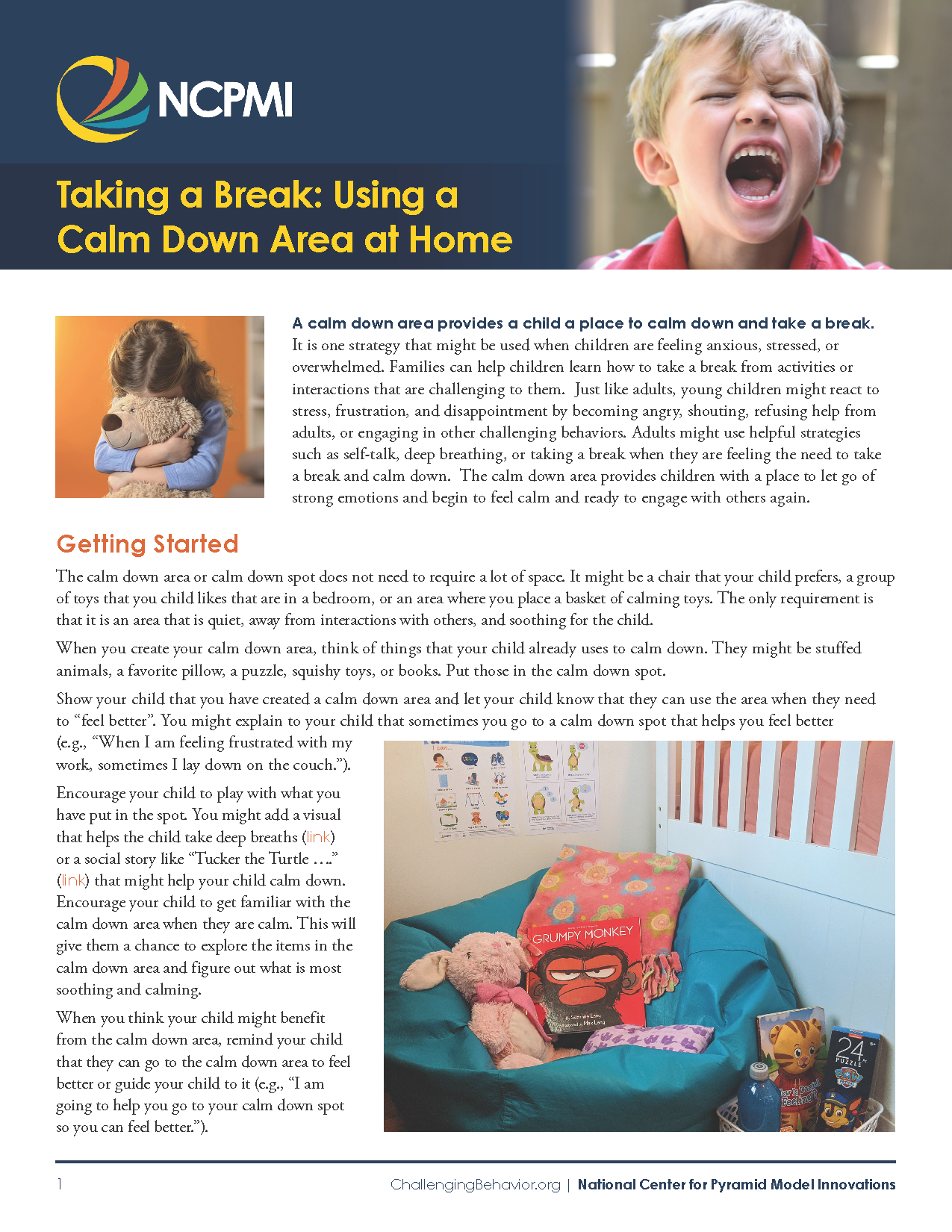
This resource includes instructions and tips for families on how to create a calm down area at home.

This resource includes instructions and tips for families on how to create a calm down area at home.

This tipsheet includes suggestions on how to develop and teach family rules. A template is included for families to create a rules poster with their child.
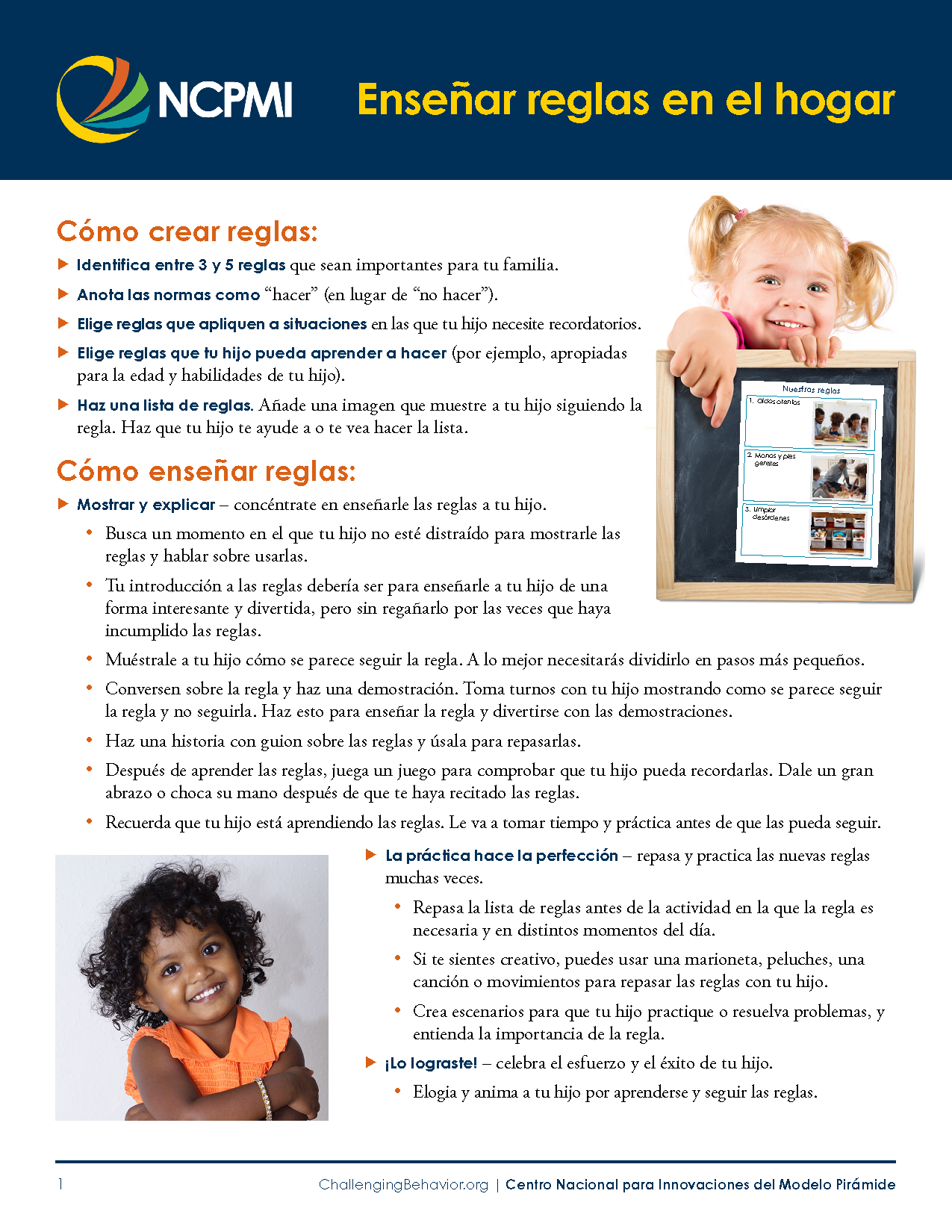
This tipsheet includes suggestions on how to develop and teach family rules. A template is included for families to create a rules poster with their child.
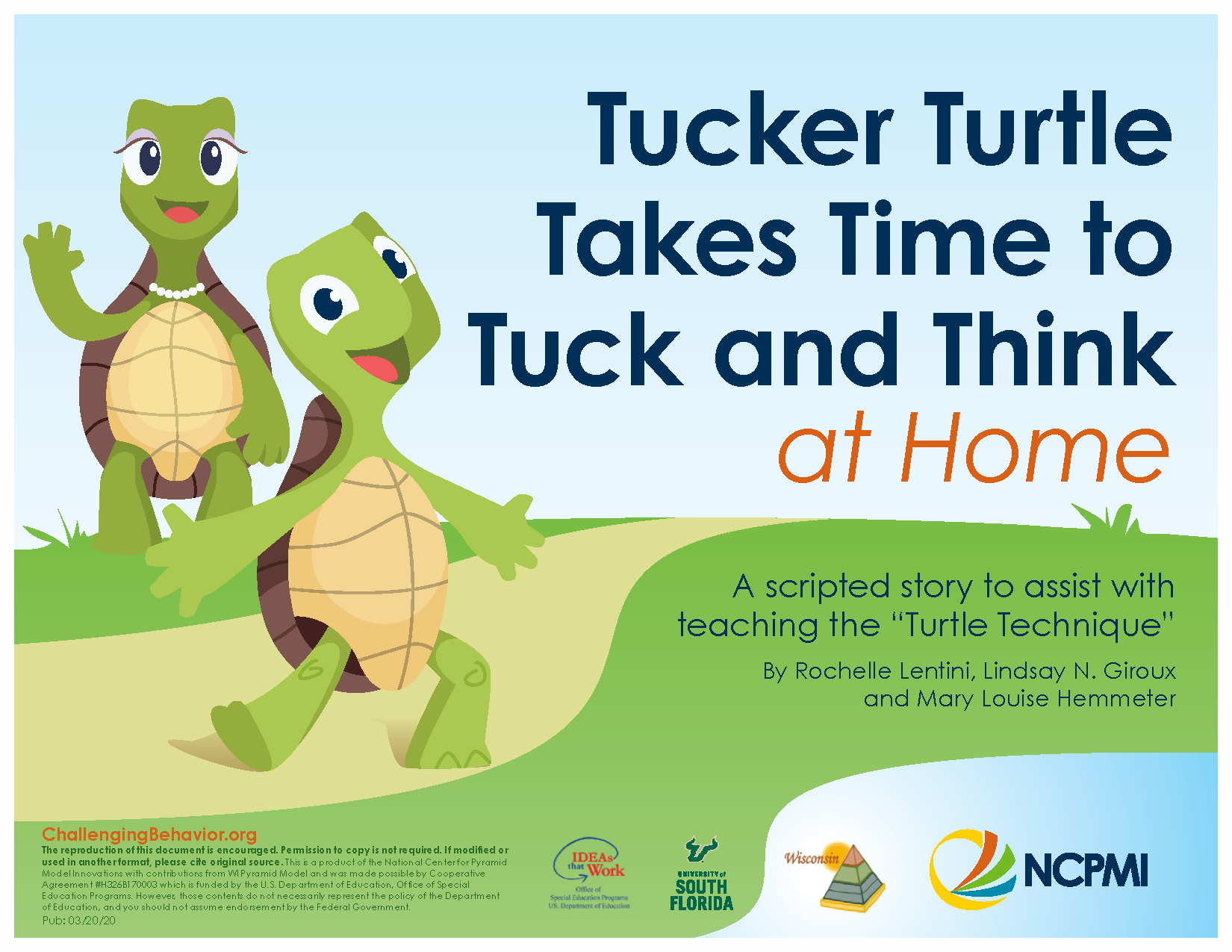
Tucker the Turtle provides a scripted story to teach young children how to calm down when they have strong feelings by tucking into their shell and taking deep breaths. The story also includes visuals to help children learn how to use the strategy.

Tucker the Turtle provides a scripted story to teach young children how to calm down when they have strong feelings by tucking into their shell and taking deep breaths. The story also includes visuals to help children learn how to use the strategy.

Tucker the Turtle provides a scripted story to teach young children how to calm down when they have strong feelings by tucking into their shell and taking deep breaths. The story also includes visuals to help children learn how to use the strategy.
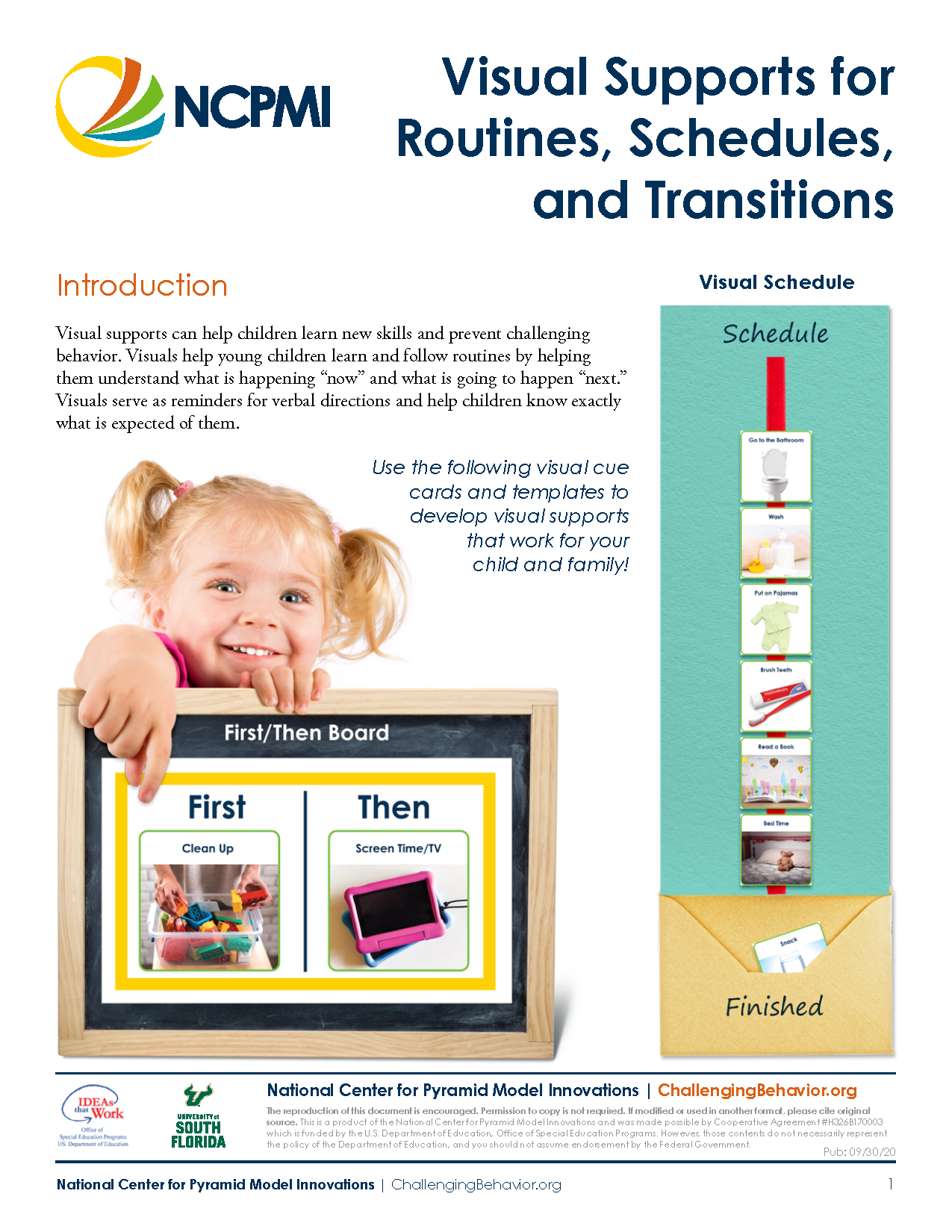
This resource provides families with instructions and resources to develop and use visual schedules, routine cards, and first/then boards.

This resource provides families with instructions and resources to develop and use visual schedules, routine cards, and first/then boards.

Scripted story to help children understand the steps to problem solving. Includes problem scenario cards to help children practice finding a solution to common social problems.

Scripted story to help children understand the steps to problem solving. Includes problem scenario cards to help children practice finding a solution to common social problems.

Scripted story to help children understand the steps to problem solving. Includes problem scenario cards to help children practice finding a solution to common social problems.

Scripted story to help children understand the steps to problem solving. Includes problem scenario cards to help children practice finding a solution to common social problems.

Early interventionists can use this written manual in the joint planning process with caregivers to organize and write out a plan to implement a caregiving practice with their child in between home visits. Encourage caregivers to leave the plan in an easy place to refer to as they need it.

Early interventionists can use this written manual in the joint planning process with caregivers to organize and write out a plan to implement a caregiving practice with their child in between home visits. Encourage caregivers to leave the plan in an easy place to refer to as they need it.

Early interventionists can use this form during home visits with caregivers to help them talk through their current daily routines as well as help them to plan out the ways they will embed supports that are responsive to their infant or toddler’s social-emotional development and teach new skills during specific moments in the family’s day.

Early interventionists can use this form during home visits with caregivers to help them talk through their current daily routines as well as help them to plan out the ways they will embed supports that are responsive to their infant or toddler’s social-emotional development and teach new skills during specific moments in the family’s day.
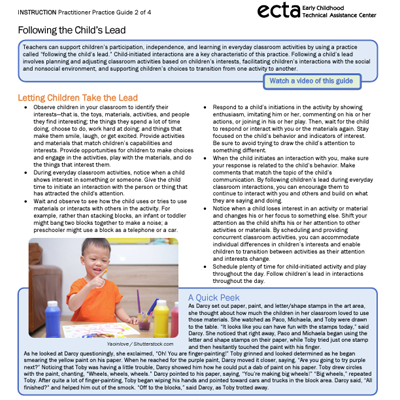
Teachers can support children’s participation, independence, and learning in everyday classroom activities by using a practice called “following the child’s lead.” Child-initiated interactions are a key characteristic of this practice. Following a child’s lead involves planning and adjusting classroom activities based on children’s interests, facilitating children’s interactions with the social and nonsocial environment, and supporting children’s choices to transition from one activity to another.

Para favorecer la participación, la independencia y el aprendizaje durante las actividades diarias, los maestros pueden usar una práctica llamada “dejar que el niño dirija”. Las interacciones iniciadas por los niños son la principal característica de esta práctica. Para seguir la dirección del niño es necesario planificar y adaptar a los intereses del niño las actividades del aula, facilitar las interacciones de los niños con el entorno social y no social y apoyar sus decisiones a la hora de pasar de una actividad a otra.
Teachers can support children’s participation, independence, and learning in everyday classroom activities by using a practice called “following the child’s lead.” Child-initiated interactions are a key characteristic of this practice. Following a child’s lead involves planning and adjusting classroom activities based on children’s interests, facilitating children’s interactions with the social and nonsocial environment, and supporting children’s choices to transition from one activity to another.

Multiple resources for data collection tools.

This resource outlines guidance for identifying, preparing, and supporting practitioners responsible for facilitating the development and implementation of individualized positive behavior support (IPBS) plans in early childhood Pyramid Model settings.





